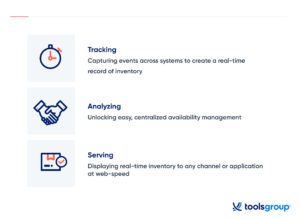The Case for Real-Time Perpetual Inventory Signals in Manufacturing
Once upon a time, the world of manufacturing was a relatively stable place.
But then, supply chain disruption became the rule instead of the exception, consumers changed their tastes as often as their socks, and global competition started playing hardball.
Suddenly, managing inventory is the name of the game for companies trying to manage working capital and maximize profit while keeping customers happy.
So how does a manufacturer navigate this rollercoaster?
With crystal clear, up-to-the-minute, and accurate data that enables organizations to see what’s happening across their entire supply chain and take smart, decisive action.
And that’s where real-time perpetual inventory signals come in.
In this blog post, we’ll explore the challenges of inventory management in today’s manufacturing landscape, discuss the importance of a “single source of truth” for global inventory, and introduce a powerful solution that can help manufacturers transform their operations and drive profitability.
The Challenge: Siloed Inventory Data and Lack of Visibility
One of the primary obstacles in inventory management is the prevalence of siloed data across multiple execution systems.
The larger the company, the greater the danger of duplicative, conflicting, or siloed systems.
This is especially prevalent in organizations that have experienced growth through mergers and acquisitions and now need to reconcile multiple ERP, WMS, shipping, and transportation systems.
When reference data – such as product codes, supplier information, and warehouse locations – is misaligned across systems, it can cause discrepancies in transactional data, leading to inaccurate inventory levels and unreliable performance metrics.
According to Gartner, these issues can lead to missed manufacturing deadlines and wasted capital.
Plus, accurate inventory information is the key to optimal decision-making.
Without updated data that can offer clear insights, manufacturers face increased costs and a decline in on-time, in-full (OTIF) delivery performance and overall efficiency.
In a world of heightened customer expectations, this damages customer loyalty and brand reputation and undercuts financial goals.
Let’s take a closer look.
Looking for more Gartner-related insights?
Manufacturing Issues Caused by Latency: Poor Visibility, Excess Inventory, and Bottlenecks
Latency in data updates across disparate systems can cause manufacturers to misinterpret demand and inventory levels.
Companies can end up with incorrect order fulfillment, stock discrepancies, and ultimately, customer dissatisfaction.
The lack of real-time visibility makes it difficult to understand how best to reduce inventory and can lead to poor production planning, resulting in either too little of the right product or too much of the wrong one.
Excess Inventory
Overstocking inventory can tie up valuable working capital, increase storage costs, and lead to product obsolescence.
That’s not good news for a company’s bottom line (or for the environment).
In fact, recent data shows that manufacturer inventory levels are up nearly 10% year over year.
This means cash and capital is tied up in excess inventory, unable to be deployed for other strategic initiatives.

There’s also the issue of the dreaded “bullwhip effect” wherein demand signals pass through the supply chain, growing in amplitude, until manufacturers are left with a distorted and inaccurate view of market wants…and excess inventory.
Conflicting data only contributes to the confusion around misinterpreted demand signals and exacerbates the issue of surplus stock.
Shortages
On the flipside, lack of accurate internal data can stall manufacturing production itself.
Let’s say, for instance, the raw materials expected to be available for production have been consumed already.
But that information has not been properly communicated.
Machines are standing at the ready – but they can’t produce anything.
Bottlenecks like these can result in finished goods stockouts that leave you with lost sales and dissatisfied customers.
The Solution: A Real-Time Dynamic Data Unification Platform
To overcome these challenges, manufacturers need timely, accurate data, aligned across all systems to ensure the accuracy of inventory levels, performance metrics, and transactional data.
How do they achieve this?
With a real-time dynamic data unification platform that consolidates data from multiple sources, providing a single, up-to-date source of truth for all inventory information.
By capturing real-time transactional data from multiple sources, including ERP, WMS, and other execution systems, the platform provides a unified view of inventory across the entire supply chain, enabling better decision-making and more effective inventory management.
It empowers manufacturers to proactively identify and address potential inventory issues, improve operational efficiency, and drive better overall performance.
How a Data Unification Platform Works
A data unification platform streamlines inventory management by:

The platform continuously tracks and analyzes inventory data from multiple sources, providing real-time updates and insights to help manufacturers make informed decisions.
By offering a unified, real-time view of days of inventory (DOI) for every location within the supply chain, manufacturers can quickly identify potential issues, such as stockouts or excess inventory, and take appropriate action to achieve healthy inventory levels.
The platform also enables manufacturers to improve supplier relationships by providing real-time visibility into inventory levels, demand fluctuations, and supply chain performance with their key vendors.
Benefits of Real-Time Perpetual Inventory Signals
Implementing a data unification platform provides real-time perpetual inventory signals and offers numerous benefits to manufacturers.
-
Manufacturers can better meet customer expectations by maintaining optimal stock levels and minimizing stockouts, ultimately leading to increased customer satisfaction.
-
By offering a more accurate, real-time view of inventory levels and improving network-wide visibility, the platform helps manufacturers optimize their inventory management, reducing excess stock and freeing up valuable working capital.
-
Real-time inventory visibility enables manufacturers to negotiate better terms with suppliers, leading to improved margins and stronger supplier relationships.
At the end of the day, data is only as powerful as the insights you gain from it.
A single source of truth doesn’t just align information across your enterprise.
It empowers the teams who are making daily decisions to be accurate, fast, and confident in their planning and execution.
And the better those decisions, the bigger the benefits for customers and business goals.







